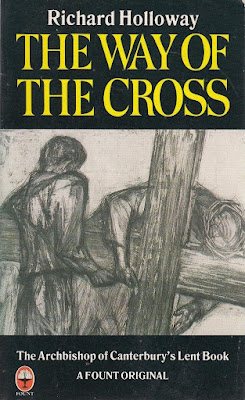Wednesday, April 3, 2024
Monday, March 11, 2024
A Brief Book Review: The Way of the Cross
A Brief Book Review: The Way of the Cross
Author: Richard Holloway, with a Foreword by the Archbishop of Canterbury, Robert Runcie
Publisher: Collins Fount Paperbacks, in association with Faith Press, 121 pages
The Author
The Rev. Richard Holloway, born in Glasgow, completed his theological studies in Edinburgh, London and New York. He was ordained a deacon in 1959, and a priest in 1960, serving two parishes in Glasgow until spending a sabbatical year (1967-8) at Union Theological Seminary in New York. His other pastorates included Old St. Paul’s, Edinburgh, the Church of the Advent, Boston, and Vicar of St. Mary Magdalen, Oxford. He also served as Bishop of Edinburgh, and was elected Primus of the Scottish Episcopal Church in 1992. In addition to this volume, he is the author of several other books.
Contents
This volume, in addition to 8 chapters, consists of Acknowledgements, Foreword by the Archbishop of Canterbury, a poem called Crux by Bob Bridges, and an Epilogue. With the exception of the first chapter, at the end of all the others there are questions for discussion.
Brief Observations
This wee volume contains meditations on seven of the fourteen traditional stations of the cross, combined with commentary on biblical texts and various literary citations, including: The Return of Arthur; The Last of the Just; Murder in the Cathedral and Four Quartets; The Mystery of Suffering; Too Late the Phalarope; The Ballad of Reading Gaol.
According to Holloway, the Passion of Jesus has a multitude of meanings, both reveals insightful truths, and transcends human explanations. The Passion contains revelation and mystery, as well as the presence of evil and holiness.
Some of the factors the author mentions in the trial and killing of Jesus are: envy, power and its abuse over against weakness and love, the fall and original sin, scapegoating the Jews, Jesus’s acceptance of and public association with women in contrast to the discrimination against women, the sin of self-deception.
Holloway, without naming them, reflects on the familiar views of atonement—endeavouring to understand and respond to them morally and theologically. He speaks of Jesus in front of us, for us and in us—bringing us forgiveness and new life.
The volume’s short epilogue is titled “Resurrection,” which ends with a citation from C.S. Lewis’s, The Last Battle.
This little work seems somewhat dated—published in 1986—and contains sexist language; and takes on the Passion that readers might argue about or disagree with.
For others, it may help them in their Lenten spiritual journey.
Saturday, February 3, 2024
Tuesday, January 9, 2024
A Brief Book Review: The Collector
The Collector
Author: Daniel Silva
Publisher: Harper An Imprint of HarperCollins Publishers, paperback, 401 pages, including Author’s Note, and Acknowledgments
Reviewed by Rev. Garth Wehrfritz-Hanson
Author
Daniel Silva is a New York Times bestselling author of 25 novels. Many are familiar with his thriller series featuring Gabriel Allon, a spy and art restorer. His novels have been translated into over 30 languages. Silva and his television journalist wife, Jamie Gangel, are the parents of twins, Lily and Nicholas, and they live in Florida.
Contents
This novel consists of four parts: Part One The Concert, Part Two The Conspiracy, Part Three The Contact, and Part Four The Conclusion.
The Collector, like most, if not all, of Daniel Silva’s novels has a thrilling plot, involving many characters, and including a number of circumstances, in various places—including Italy, Germany, Denmark, and Russia. It is, like his other novels, a well written page-turner.
Gabriel Allon supposedly is trying to retire. However, The Concert, by Dutch painter Johannes Vermeer, and 13 other works of art have been stolen from Boston’s Isabella Stewart Gardner Museum. Through a series of events, Allon eventually becomes involved with the PET, Denmark’s Security and Intelligence Service. The relationship between DanskOil and RuzNeft is not going well, and the Danes want to end it. It is suspected that one or more Russian political and economic elitists were linked to the theft of Vermeer’s painting. Moreover, Allon and other Western intelligence agencies become aware of a Russian plot to, if successful, potentially start a nuclear war.
Did Allon and the Western intelligence agencies recover the Vermeer painting, and did they succeed in preventing an apocalyptic nightmare? Read the novel to find out.



